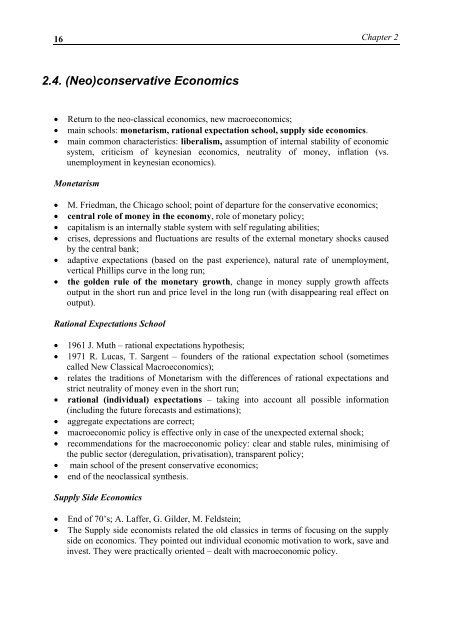MacroeconomicsI_working_version (1)
Create successful ePaper yourself
Turn your PDF publications into a flip-book with our unique Google optimized e-Paper software.
16<br />
Chapter 2<br />
2.4. (Neo)conservative Economics<br />
• Return to the neo-classical economics, new macroeconomics;<br />
• main schools: monetarism, rational expectation school, supply side economics.<br />
• main common characteristics: liberalism, assumption of internal stability of economic<br />
system, criticism of keynesian economics, neutrality of money, inflation (vs.<br />
unemployment in keynesian economics).<br />
Monetarism<br />
• M. Friedman, the Chicago school; point of departure for the conservative economics;<br />
• central role of money in the economy, role of monetary policy;<br />
• capitalism is an internally stable system with self regulating abilities;<br />
• crises, depressions and fluctuations are results of the external monetary shocks caused<br />
by the central bank;<br />
• adaptive expectations (based on the past experience), natural rate of unemployment,<br />
vertical Phillips curve in the long run;<br />
• the golden rule of the monetary growth, change in money supply growth affects<br />
output in the short run and price level in the long run (with disappearing real effect on<br />
output).<br />
Rational Expectations School<br />
• 1961 J. Muth – rational expectations hypothesis;<br />
• 1971 R. Lucas, T. Sargent – founders of the rational expectation school (sometimes<br />
called New Classical Macroeconomics);<br />
• relates the traditions of Monetarism with the differences of rational expectations and<br />
strict neutrality of money even in the short run;<br />
• rational (individual) expectations – taking into account all possible information<br />
(including the future forecasts and estimations);<br />
• aggregate expectations are correct;<br />
• macroeconomic policy is effective only in case of the unexpected external shock;<br />
• recommendations for the macroeconomic policy: clear and stable rules, minimising of<br />
the public sector (deregulation, privatisation), transparent policy;<br />
• main school of the present conservative economics;<br />
• end of the neoclassical synthesis.<br />
Supply Side Economics<br />
• End of 70’s; A. Laffer, G. Gilder, M. Feldstein;<br />
• The Supply side economists related the old classics in terms of focusing on the supply<br />
side on economics. They pointed out individual economic motivation to work, save and<br />
invest. They were practically oriented – dealt with macroeconomic policy.




